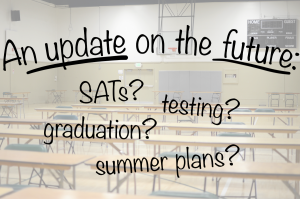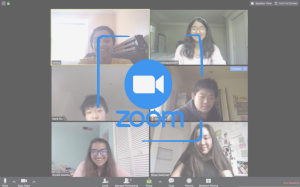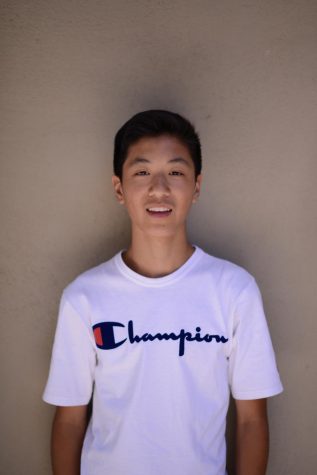Going virtual: How teachers have adapted hands-on activities online
Students work on a watercolor project in Pilar Aguero-Esparza’s Study of Visual Arts class. She made and mailed packages of art supplies to each student to help them continue their art at home.
April 26, 2020
Virtual dance auditions. Online orchestra practice. Mailing art supplies and lab notebooks. Conducting experiments at home.
With the campus closed and a shelter-in-place order throughout California, teachers have adapted to online learning, inventing creative solutions to replace hands-on activities and labs with students.
Teachers have been allowed to return to campus if needed, with several taking advantage of the facilities to teach from their classrooms. Upper school Academic Dean Kelly Horan emphasized the freedom faculty have been given to plan their own curriculums.
“They are experts in their subjects. They are excellent teachers, and so, we give them a lot of freedom,” Horan said. “They get to use their discretion what is best in this current situation. That goes for content, it goes for assessments, it goes for lots of things.”
Horan also clarified that the upper school would not be shifting to a pass-fail system, instead keeping with letter grades.
“We had at least half of our semester in on letter grades. So we are confident that the teachers are still holding their classes in the way that lends themselves to the assessment needed,” she said.
Final exams, scheduled for the first week of June, will be held online and adapted to the material covered this year. In the meantime, several teachers whose classes rely on hands-on activity — art, dance, orchestra and chemistry — have created unique solutions.
Art
Upper school visual arts teacher Pilar Aguero-Esparza worried that certain assignments would be impossible to complete if her students didn’t have specific tools at home, such as markers or even rulers. She created packets of basic materials which she then mailed to each of her students.
In addition, Aguero-Esparza has experimented with video tutorials as a means to give students a visual lesson that differs from the usual lecture.
Dance
Dance classes, such as Kinetic Krew and Harker Dance Company have also moved online in many innovative ways. Upper School dance teacher Karl Kuehn has moved auditions for next year’s dance teams online, a format popular within the dance community even before the pandemic.
Kuehn and upper school dance teacher Rachelle Haun have also been teaching and interacting their regular classes over Zoom.
“I’ve gone to campus and led warm-ups that the students have followed on Zoom. We’ve recorded choreography that we’ve sent out to the dancers for them to learn, and then for them to send back to us so that we can assess our progress,” Kuehn said.
The dancers continue to exercise and learn new skills through online Zoom meetings.
Orchestra
Upper school instrumental music teacher David Hart adapted his curriculum to embrace the online learning format, facing some difficulties organizing orchestras and bands.
“Any ensemble in today’s world is typically, especially at schools, centered around group interaction. So, at the moment, rehearsals usually are a collection of individuals working on a set repertoire, or any sort of music that they agree is important,” he said.
The pandemic has had surprising benefits for student musicians. Dr. Hart assigned students to record themselves playing, allowing for increased individualized feedback than in a traditional group setting. Many online resources such as live performances are also now free for students to use.
“There are a lot of live concerts right now of orchestras or musicians. The Berlin Philharmonic made their whole library open, which is usually a subscription of money each month. It’s free. Our kids are watching one a week and giving comments and just being inspired,” Dr. Hart said.
Currently, Dr. Hart is working with orchestra students to record a final piece as a parting gift to the seniors, who had their final year shortened due to the pandemic.
“We’re deciding to thank our seniors this year because they’re so wonderful. We’re deciding to do a group recording remotely. It’s a lot of work, but we’re going to do a click track, and they’re recording a piece that Spencer Cha [(10)] wrote, featuring all of our seniors,” he said.
Science
Meanwhile, lab-heavy courses such as chemistry teacher Andrew Irvine’s classes are unable to continue the planned lab assignments.
“We have done tons of labs already. And so it’s unfortunate that we’re losing some additional labs that we had planned, but I feel like my students have already gotten a pretty substantial laboratory base,” he said. “That said, you can’t just call up parents and send an email saying you need to grab some hydrochloric acid.”
In his chemistry class, Irvine has created engaging assignments that modeled labs without using chemicals.
“We did a half-life activity where kids were away from their computer, they had to find 100 pennies or something like it to do this activity, and they collected data. And then there is an analysis part. So it was a lot of experience without the chemistry,” he said.
He plans to use online simulations to help teach upcoming units, recognizing that the online format will require significant on-the-spot changes.
“Sometimes, whatever I do in class doesn’t make that connection, or my kids need more time on it,” Irvine said. “It’s flexible, but we have a plan.”


















![“[Building nerf blasters] became this outlet of creativity for me that hasn't been matched by anything else. The process [of] making a build complete to your desire is such a painstakingly difficult process, but I've had to learn from [the skills needed from] soldering to proper painting. There's so many different options for everything, if you think about it, it exists. The best part is [that] if it doesn't exist, you can build it yourself," Ishaan Parate said.](https://harkeraquila.com/wp-content/uploads/2022/08/DSC_8149-900x604.jpg)




![“When I came into high school, I was ready to be a follower. But DECA was a game changer for me. It helped me overcome my fear of public speaking, and it's played such a major role in who I've become today. To be able to successfully lead a chapter of 150 students, an officer team and be one of the upperclassmen I once really admired is something I'm [really] proud of,” Anvitha Tummala ('21) said.](https://harkeraquila.com/wp-content/uploads/2021/07/Screen-Shot-2021-07-25-at-9.50.05-AM-900x594.png)







![“I think getting up in the morning and having a sense of purpose [is exciting]. I think without a certain amount of drive, life is kind of obsolete and mundane, and I think having that every single day is what makes each day unique and kind of makes life exciting,” Neymika Jain (12) said.](https://harkeraquila.com/wp-content/uploads/2017/06/Screen-Shot-2017-06-03-at-4.54.16-PM.png)








![“My slogan is ‘slow feet, don’t eat, and I’m hungry.’ You need to run fast to get where you are–you aren't going to get those championships if you aren't fast,” Angel Cervantes (12) said. “I want to do well in school on my tests and in track and win championships for my team. I live by that, [and] I can do that anywhere: in the classroom or on the field.”](https://harkeraquila.com/wp-content/uploads/2018/06/DSC5146-900x601.jpg)
![“[Volleyball has] taught me how to fall correctly, and another thing it taught is that you don’t have to be the best at something to be good at it. If you just hit the ball in a smart way, then it still scores points and you’re good at it. You could be a background player and still make a much bigger impact on the team than you would think,” Anya Gert (’20) said.](https://harkeraquila.com/wp-content/uploads/2020/06/AnnaGert_JinTuan_HoHPhotoEdited-600x900.jpeg)

![“I'm not nearly there yet, but [my confidence has] definitely been getting better since I was pretty shy and timid coming into Harker my freshman year. I know that there's a lot of people that are really confident in what they do, and I really admire them. Everyone's so driven and that has really pushed me to kind of try to find my own place in high school and be more confident,” Alyssa Huang (’20) said.](https://harkeraquila.com/wp-content/uploads/2020/06/AlyssaHuang_EmilyChen_HoHPhoto-900x749.jpeg)











